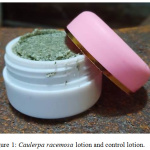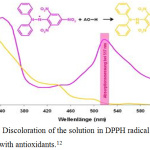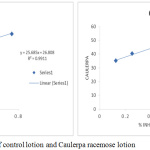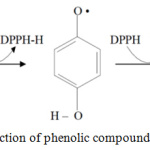Antioxidant Activity of the Sea Grape (Caulerpa Racemasa) as a Lotion
Aryanti Susilowati , Ardi Eko Mulyawan* and Tri Widayati Putri
, Ardi Eko Mulyawan* and Tri Widayati Putri
Sekolah Tinggi Ilmu Kelautan Balik Diwa, Makassar, Sulawesi Selatan, Indonesia.
Corresponding Author E-mail: ardieko354@gmail.com
DOI : http://dx.doi.org/10.13005/ojc/350427
Article Received on : 03-11-2018
Article Accepted on : 02-07-2018
Article Published : 22 Jul 2019
Caulerpa racemose is one type of seaweed that has the greatest potential in Indonesia. Caulerpa racemose has attracted many attentions as an antioxidant agent which is potential for cosmetic industries. The study aims to analyze the antioxidant content of Caulerpa racemose and determining its effectiveness as an anti-aging lotion. testing the antioxidant activity of Caulerpa racemosa using the DPPH method. Caulerpa racemosa contains phenol compounds that function as antioxidants. The results showed that value antioxidant activity of Caulerpa racemosa lotion is very higher, value IC50 reach 0,58 ppm (a compound is called a very strong antioxidant if the value of IC50 is <50 ppm) and the results test of Caulerpa racemose lotion was appropriate with quality standard SNI 16-4399-1996 about the standards sunscreen preparations for the skin. This paper presents the first-time production lotion from Caulerpa racemose.
KEYWORDS:Anti-Aging Lotion; Antioxidant; Caulerpa Racemose; DPPH
Download this article as:| Copy the following to cite this article: Susilowati A, Mulyawan A. E, Putri T. W. Antioxidant Activity of the Sea Grape (Caulerpa Racemasa) as a Lotion. Orient J Chem 2019;35(4). |
| Copy the following to cite this URL: Susilowati A, Mulyawan A. E, Putri T. W. Antioxidant Activity of the Sea Grape (Caulerpa Racemasa) as a Lotion. Orient J Chem 2019;35(4). Available from: https://bit.ly/2xXWduD |
Introduction
One of the seaweed type in Indonesia that is quite promising is Caulerpa racemosa or sea grape. Caulerpa racemosa production is 10.3 million tons per year and increases every year.1 This species in South Sulawesi is commonly known as lawi-lawi or bu’ne while in Java it is known as latoh.
Caulerpa racemosa has high nutritional content such as vegetable protein, minerals and vitamins.2 Moreover, Caulerpa racemosa has bioactive compound like tannin, phenol, flavonoid, alkaloid that can inhibit the growth of bacteria and fungi, so that can be used in medical and cosmetic fields.3,4 Phenol compounds found in Caulerpa racemose act to protect body cells from free radical damage by binding to free radicals so as to prevent inflammation and inflammation in the body’s cells.5
Caulerpa racemosa is very common in coastal areas and coral reefs. In its utilization, this type of seaweed. Caulerpa racemosa is still very rarely processed.6 One of the promising products of Caulerpa racemosa is the manufacture of lotions because they are rich in antioxidants which are good for the skin.
A lotion is a form of an emulsion that is defined as a mixture of two phases, namely water and fat, which is stabilized with an emulsion system and if placed at room temperature will be a liquid.7 The function of skin lotion is that it can maintain skin moisture, soften skin, prevent water loss, and cleanse skin.8 The study aims to analyze the antioxidant content of Caulerpa racemose and determining its effectiveness as an anti-aging lotion. The manufacture of lotions from Caulerpa racemosa is one of a promising process that can be done to increase the selling value of Caulerpa racemose.
Materials and Method
The equipment used in the research is analytical scale, mortar and pestle, hotplate stirrer, oven, Ostwald viscometer, drop pipette, beaker, measuring flask, pycnometer, pH meter, petri dish, and spectrophotometer UV-Vis US-110PC. The materials used in the research are Caulerpa racemosa, nipagin and nipasol, propylene glycol, stearic acid, triethanolamine, DPPH, vitamin C pa, aquades, aqubides, filter paper, pH buffer and label paper.
Production of Caulerpa racemose lotion
Production of Caulerpa racemose lotion and control composed of two phases namely oil phase and an aqueous phase. For Oil phase, dissolve Caulerpa racemose and stearic acid in a hot mortar and added TEA. For Aqueous phase, dissolve nipagin and nipasol with propylene glycol and added aquades. Then mix the two phases to form a lotion.9 For control lotion the production without the addition of Caulerpa racemose.
Tabel 1: Formulation of Caulerpa racemose lotion.9
| Materials | Control | Caulerpa racemose |
| Caulerpa racemosa | x | 10 |
| Stearic Acid | 14,2 | 14,2 |
| Triethanolamine | 1 | 1 |
| Nipagin | 0,1 | 0,1 |
| Nipasol | 0,05 | 0,05 |
| Propilenglikol | 5 | 5 |
| Aquades | 100 | 100 |
The Caulerpa racemose lotion then tested according to SNI 16-4399-1996 standard that is an organoleptic test, pH, density, viscosity, and microbial contamination.
 |
Figure 1: Caulerpa racemosa lotion and control lotion. |
Testing of Caulerpa Racemose Lotion
DPPH Solution
Weighed as much as 10.0 mg of DPPH (2,2-diphenyl-1-pikril hydrazine) then dissolved in ethanol p a using a volumetric flask 100 mL, as a stock solution. For a concentration of 0.125 ppm, DPPH solution was pipetted as much as 1.50 ml then the volume was filled with ethanol p.a to 10.0 ml and the absorbance was observed in a spectrophotometer. Performed again for each concentration of 0.25 ppm, 0.5 ppm, and 0.75 ppm. The solutions is then transferred to a brown glass and allowed to stand for 30 minutes, then the absorption is measured at the maximum DPPH wavelength of 515 nm.
Testing of Caulerpa Racemose lotion Antioxidant Activity using DPPH Method
As much as 2.5 grams of a lotion is put into a mortar, then added 5.0 mL ethanol p. a. Then centrifuged for 10 minutes, then filtered with filter paper until the solution is clear. The filtrate was put into a volumetric flask, added 2.0 mL of DPPH solution and the volume was filled with ethanol p.a. up to 10 mL, incubated at 37°C for 30 minutes, put in a cuvette, then absorbed using a Spectrophotometer UV-Vis with a wavelength of 515 nm. Antioxidant activity is expressed by% inhibition.

Information :
Abs Kontrol : Solution + DPPH
Abs Sample : Solution + DPPH + Sample
Specifically, a compound is called a very strong antioxidant if the IC50 value is <50 ppm, it is stated strongly if the IC50 value is 50-100 ppm, expressed as a medium if the IC50 value is 101-150 ppm, and is declared weak if the IC50 value is> 150 ppm.10
To find out the lotion quality of Caulerpa racemosa, measurement of pH value, viscosity, density, and total microbial contamination need to be considered so as to get a quality lotion.
Result and Discussion
Antioxidant Activity of Caulerpa Racemose Lotion
DPPH (1,1-diphenyl-2-picrylhydrazyl) is a free radical that can react with compounds that can donate hydrogen or proton atoms, thus forming non-radical compounds that are non-radical DPPH used in testing antioxidant activity in an ingredient/extract. Due to of unpaired electrons, DPPH gives a strong absorption at an absorbance of about 517 nm. When the electrons become paired by the presence of free radical catchers, the absorbance decreases stoichiometrically according to the number of electrons taken. The presence of antioxidant compounds can change the color of DPPH solution from purple to yellow.11
 |
Figure 2: Discoloration of the solution in DPPH radical reaction with antioxidants.12 |
Determination of antioxidant activity from lotions by graphing the relationship between concentration (ppm) and% inhibition. The equation of the regression obtained from the graph is used to calculate the value of Inhibition Concentration (IC50).
 |
Figure 3: Graph of measurements of control lotion and Caulerpa racemose lotion. |
Calculation of IC50 value for control lotion based on graph results :
a 26,808
b 25,685x
r2 0,9911
y a + bx
y 26,808 + 25,685x

Calculation of IC50 value for Caulerpa racemose lotion based on graph results :
a 31,496
b 32,011x
r2 0,9954
y a + bx
y 31,496 + 32,011x

Table 2. the result of Antioxidant activity from Caulerpa racemosa lotion and control lotion.
| No | Sample | Sample | Concentration | Absorbance | Absorbance | % antioxidant | IC 50 |
| weight | Sample | DPPH | |||||
| 1 | Control | 1.425 | 0.125 | 0.525 | 0.905 | 29.47 | 0.90 |
| 1.425 | 0.250 | 0.473 | 0.905 | 33.50 | |||
| 1.425 | 0.500 | 0.383 | 0.905 | 40.48 | |||
| 1.425 | 0.750 | 0.318 | 0.905 | 45.52 | |||
| 2 | Caulerpa racemosa | 1.095 | 0.125 | 0.557 | 0.905 | 35.12 | 0.58 |
| 1.095 | 0.250 | 0.506 | 0.905 | 40.26 | |||
| 1.095 | 0.500 | 0.440 | 0.905 | 46.92 | |||
| 1.095 | 0.750 | 0.353 | 0.905 | 55.70 |
Caulerpa racemosa lotion has strong antioxidant activity compared to control lotions or without the addition of Caulerpa racemosa. IC50 values less than 0.05 mg / mL or 50 ppm identify that the lotion has very strong antioxidant activity. The high value of anti-oxidant activity in the lotion Caulerpa racemosa due to Caulerpa racemosa has a bioactive component that is the content of polyphenol compounds which have hydroxy groups substituted in ortho positions and para to – OH and -OR groups so that the compounds have antioxidant activity.
 |
Figure 4: The reaction of phenolic compounds with DPPH.13 |
pH Value
pH lotion testing was carried out at the beginning of manufacture and for 4 weeks storage using a pH meter. Lotion with too acidic pH can irritate the skin while lotions that are too alkaline can make the skin dry so the preparation must have a pH that is suitable for the skin.
Table 3: pH value of Caulerpa racemosa lotion and control lotion.
| Sample | Initial pH | pH after 4 weeks | |
| Control | 8,02 | 8,15 | |
| Caulerpa racemosa | 6,12 | 5,74 | |
The results of pH measurements showed that the pH value of Caulerpa racemosa lotion was 6.12 and after 4 weeks of storage the pH value decreased to 5.74. Decreasing the pH of the lotion Caulerpa racemosa can be caused by the hydrolysis of acidic compounds that can be triggered by an increase in temperature during storage. However, based on Sunscreen Quality Standards (SNI 16-4399-1996), the pH value requirements are safe for the skin, namely pH 4.5 – 8.0 so that the pH of this lotion has fulfilled these requirements. While the control lotion had an initial pH of 8.02 and after 4 weeks of storage, the pH increased to 8.15, due to the water phase and oil phase on the control lotion begins to decompose so that the pH value of the control lotion increases.
Viscosity
Viscosity test is done to determine the thickness of a sample from the resistance of a substance to flow. The higher the flow viscosity, the greater the resistance. Viscosity affects the rate of absorption of lotion on the skin, the thicker the longer the absorption of the drug will be. The lotion measured its initial viscosity and after being stored for 4 weeks at room temperature.
Table 4: Viscosity value of Caulerpa racemosa lotion and control lotion.
| Sample | Initial viscosity (Cps) | viscosity after 4 weeks (Cps) | |
| control | 53,4 | 73,40 | |
| Caulerpa racemosa | 900 | 1100 | |
Note : The fluidity unit is the centipoise (cps).
Viscosity is influenced by the selection of lotion ingredients, such as surfactants, disperse particles and the proportion of both water and oil phases. The viscosity value for control lotions is very low compared to lotions with the addition of Caulerpa racemosa. Viscosity value increases after 4 weeks of storage. This increase occurred due to evaporation of ethanol in the lotion so that the lotion thickened.
Density
Density is used to determine the absorption standard of a preparation. The smallest density identifies that the lotion has good homogeneity. The density of lotion types Caulerpa racemosa and control lotions are still in accordance with the quality standards of SNI 16-4399-1996, namely 0.95-1.05 g/mL.
Table 5: The density value of Caulerpa racemosa lotion and control lotion.
| Sample | Initial density (g/mL) | density after 4 weeks (g/mL) |
| Control | 0,9862 | 0,9793 |
| Caulerpa racemosa | 1,0255 | 1,0394 |
Total Microbial Contamination
Based on the Regulation of the Head of the Indonesian Drug and Food Control Agency No. HK.00.06.1.52.4011 in 2009, concerning the determination of the maximum limits of microbial and chemical contamination. Microbial contamination is contamination from microbes that can be harmful, one of which is Escherichia choli.14
The results of the total microbial contamination test on the lotion in accordance with the sunscreen quality standards SNI 16-4399-1996 that is a maximum of 102 colonies/gram.
Table 6: Total microbial contamination.
| Sample | Value of SPC (CFU) | Escherichia choli. |
| Caulerpa | 10 x 103 | – |
| Kontrol | 25 x 103 | – |
Note : CFU is Colony Forming Unit.
SPC is Standard Plate Count.
Antimicrobial test results showed that both lactic acid bacteria isolates from Caulerpa racemosa lotion and control lotions were able to inhibit E.coli. Organic acids produced by lactic acid bacteria are lactic acid and acetic acid. Lactic acid is the main metabolite of lactic acid bacteria. The inhibitory effect occurs because organic acid molecules enter the cell membrane and reduce the cytoplasmic pH. Hydrogen peroxide produced by the activity of lactic acid bacteria can inhibit pathogenic bacteria.15
In addition, other acids are produced by lactic acid bacteria such as acetic acid, propionate and formiate, although the production is small, but has stronger antimicrobial power than lactic acid. Lactic acid and a little acetic acid formed have an inhibitory effect on pathogenic microbes, apart from being caused by a decrease in pH below the optimum pH of pathogenic microbial growth, the presence of undissociated acid molecules that can penetrate the cell wall and disrupt the metabolic process and genetic mechanisms of pathogenic bacterial cells.16
Profile of Caulerpa racemose lotion
The results test of Caulerpa racemose lotion was appropriate with quality standard SNI 16-4399-1996 about the standards of good cosmetic production. Caulerpa racemosa lotion has a pH is 5.72; density is 1,0255 g/cm3 and viscosity is 900 Cps.
Conclusion
Based on the results of research, it can be concluded that value antioxidant activity of Caulerpa racemosa lotion is very higher, value IC50 reach 0,58 ppm using DPPH method (a compound is called a very strong antioxidant if the value of IC50 is <50 ppm) and the results test of Caulerpa racemose lotion i.e pH is 6,15; viscosity is 900; density is 1,0255; Total microbial contamination is 10 x 103. It’s appropriate with quality standard SNI 16-4399-1996 about the standards sunscreen preparations for the skin.
Acknowledgements
The authors are thankful to Laboratorium at Hasanuddin University to analyze the sample and for their support and co-operation. And authors are Grateful to Kemenristekdikti for providing financial assistance in the form of the grant.
References
- Ginting, E. S; Rejeki. S.; and Susilowati. T. Journal of Aquaculture Management and Technology. 2015, 4, 4, 82-87
- Ma’ruf, W. F.; Ibrahim, R.; Dewi, E. N.; Susanto, E.; and Amalia, U. Jurnal Saintek Perikanan, 2013, 9, 1, 68-74
- Chew, Y.L.; Y.Y. Lim, M. Omar and K.S.Khoo. Food Science and Technology. 2008. 41, 1067-1072.
- Marfuah, I.; Dewi, E.N. and Rianingsih, L. J. Peng. & Biotek. 2018, 7, 1
- Saputra. A.; Wike, A.E.P. and Riris, A. Maspari Journal. 2011, 3, 1, 30-35.
- Yudasmara, G.A. Jurnal Sains dan Teknologi. 2014, 3, 2, 468-473.
- Purwaningsih, S.; Salamah, E.; and Budiarti, T. K. Jurnal Akuatika. 2014, 5, 0853-2532.
- Purwaningsih, S.; Salamah, E. and Budiarti, T.A. Jurnal Akuatika. 2014, 5, 1, 55-62.
- Putri, T.W.; Raya, I.; Natsir, H.; And Mayasari, E. Oriental Journal Of Chemistry, 2017, 33, 6, 2848-2857.
- Garcia, E. J; Oldoni, T.L; Alencar, S.M.; Reis. A.; Loguercio, A. Braz Dent J, 2012, 23,1, 22-27.
- Ridhowati, S. and Asnani. Oseana. 2016, 51, 4, 50 – 62.
- Witt, S.; Lalk, M.; Hager, C.; and Voigt, B. DPPH-Test: Determination of Scavenger Properties, 2010.
- Cholisoh, Z. Jurnal Pharmacon. 2008, 9,1.
- Badan Pengawasan Obat dan Makanan Republik Inddonesia. Nomor HK.00.06.1.52.4011 Tentang Penetapan Batas Maksimum Cemaran Mikroba dan Kimia dalam Makanan. 2009.
- Setiarti, R. H.B.; Widyastuti, N. and Rikmawati, N.A. Jurnal Veteriner. 2017, 18, 3, 428-440.
- Meidong, R.; Doolgindachbaporn, S.; Sakai, K. and Tongpim, S. AACL Biolux. 2017, 10, 2, 455-463.

This work is licensed under a Creative Commons Attribution 4.0 International License.









